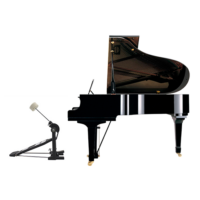Project
Amplifying the piano to investigate potential advantages.
How
The piano was amplified using seven microphones: three inside the piano and four outside. The three inside microphones were intended to amplify timbral qualities not normally audible to the audience, such as those close to the strings, providing a more detailed sound, and those near the mechanics to make them audible. The outside microphones were used for conventional instrument amplification. Each microphone had fixed digital effects, primarily compression and delay, and the volume of each was controlled live. Performances were conducted by student pairs, with one student performing the piece live and the other managing the live mixing.
Intentions
a. We anticipated that the audience, accustomed to hearing amplified piano recordings, would find the amplified sound more satisfying.
b. The project aimed to educate students about amplification and recording technologies, increasing their awareness of the possibilities.
c. Exploration of interpretive possibilities in live amplification.
Results
1. It was much easier to create both a forceful sound and a very delicate piano sound.
2. The electronics made the sound more immersive.
3. The sound picture contained more details.
4. Investigations into when the amplification could be identified or not, and how it affected the experience.
Examples
Reflection
There are at least two intriguing potentials in this study.
The first potential is closely related to the project’s research area: Live amplification of the grand piano creates a vast array of possibilities for a varied soundscape. This involves both microphone placement—we had some placed much closer to the instrument than usual—and balancing the different microphones in the overall soundscape. Where we normally struggle to bring out dynamic or tonal extremes, we can now easily create significant shifts during a piece, either as gradual transitions or abrupt changes. This makes the performer’s interpretation much more prominent and expands the opportunities to find a personal perspective on the work. However, this also requires a person at the mixing console who is aligned with the performer’s vision and possesses both musical skills and professional PA sound experience. The combination of professional sound technician Morten Elkjær and the students’ duo work was very successful in this regard.
The second possibility is much more radical in its capacity to change concert culture: A significant skill today for achieving a successful artistic career as a classical musician is volume. If you, as a singer, string player, or pianist, can fill a large concert hall with your sound, you will fundamentally have better access to reach the audience compared to your colleague who plays more softly. But what if we could simply turn up the volume? Or tweak the equalization so that the tenor suddenly sounds like Pavarotti at his best? Or if we—without altering the aesthetic paradigm otherwise—create an immersive sound experience where musicians play live, but with the help of high-quality microphones, live mixing, and an advanced PA system, provide the audience with an experience that feels familiar compared to other music experiences in 2024? Will we have lost or gained something? This is a question that is likely to become relevant for classical music culture in the near future.
